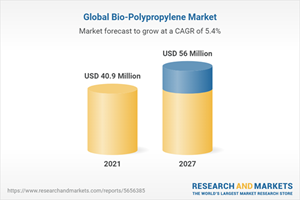Insights on the Bio-Polypropylene Global Market to 2027 - by Application and Region

Global Bio-Polypropylene Market

Dublin, Jan. 17, 2023 (GLOBE NEWSWIRE) -- The "Bio-Polypropylene Market: Global Industry Trends, Share, Size, Growth, Opportunity and Forecast 2022-2027" report has been added to ResearchAndMarkets.com's offering.
The global bio-polypropylene market size reached US$ 40.9 Million in 2021. Looking forward, the publisher expects the market to reach US$ 56 Million by 2027, exhibiting a CAGR of 5.38% during 2021-2027.
Keeping in mind the uncertainties of COVID-19, we are continuously tracking and evaluating the direct as well as the indirect influence of the pandemic on different end use industries. These insights are included in the report as a major market contributor.
Bio-polypropylene is a polymer made from natural materials which include corn, sugar cane, vegetable oil, and other bio-masses. The properties of bio-polypropylene and synthetic polypropylene are similar.
Bio-polypropylene, also known as PP, is a thermostatic polymer which has found its application in injection molding, textiles, film, packaging industry, bottles, Rubik's Cube stickers, polymer banknotes, etc. The conventional polypropylene is made from petroleum and results in emission of large amount of greenhouse gases.
However, bio-polypropylene is developed from sugar cane and other natural materials and are an eco-friendlier option compared to the conventional ones. Bio-polypropylenes have a higher melting point which also makes them eligible to be used in various plastic products such as medical apparatuses and dishwasher safe containers. They are preferred for their strength, durability, and resistance to heat and stiffness.
Bio-Polypropylene Market Trends:
A major factor driving the demand of bio-polypropylene is the fact that Injection molded parts made from this polymer are light in weight. This has resulted in the automotive sector being a major driver of this polymer. A rising trend of adopting biopolymers to reduce the overall weight of the automobiles coupled with efforts to minimize carbon emission is driving the demand of bio-polypropylene in this sector.
For instance, General Motors is using bio-polypropylene in the Cadillac DeVille for seatbacks and in the Chevrolet Impala for trim and shelving. Similarly, Ford is using bio-polypropylene for interior storage bins in the Ford Flex and for the loadfloor in the Focus BEV. Apart from the automobile industry, bio-polypropylene also finds its applications in textiles, films, food packaging, etc. This is also expected to catalyze its demand in the forecast period.
Competitive Landscape:
The competitive landscape of the market has also been examined with some of the key players being Braskem S.A., Biobent Management Services, Inc., The Dow Chemical Company, Global Bioenergies, Trellis Earth Products, Inc., Japan Polypropylene Corporation, Reliance Industries Limited, LyondellBasell Industries Holdings N.V., Exxon Mobil Corporation, and Ineos AG.
Key Questions Answered in This Report:
How has the global bio-polypropylene market performed so far and how will it perform in the coming years?
What are the key regional markets in the global bio-polypropylene industry?
What has been the impact of COVID-19 on the global bio-polypropylene market?
What is the breakup of the global bio-polypropylene market on the basis of application?
What are the various stages in the value chain of the global bio-polypropylene market?
What are the key driving factors and challenges in the global bio-polypropylene market?
What is the structure of the global bio-polypropylene market and who are the key players?
What is the degree of competition in the global bio-polypropylene market?
How is bio-polypropylene manufactured?
Report Attribute | Details |
No. of Pages | 105 |
Forecast Period | 2021 - 2027 |
Estimated Market Value (USD) in 2021 | $40.9 Million |
Forecasted Market Value (USD) by 2027 | $56 Million |
Compound Annual Growth Rate | 5.3% |
Regions Covered | Global |
Key Topics Covered:
1 Preface
2 Scope and Methodology
3 Executive Summary
4 Introduction
4.1 Overview
4.2 Properties
4.3 Key Industry Trends
5 Global Bio-Polypropylene Market
5.1 Market Overview
5.2 Market Performance
5.3 Impact of COVID-19
5.4 Market Breakup by Application
5.5 Market Breakup by Region
5.6 Market Forecast
6 Market Breakup by Application
6.1 Injection Molding
6.1.1 Market Trends
6.1.2 Market Forecast
6.2 Textiles
6.2.1 Market Trends
6.2.2 Market Forecast
6.3 Films
6.3.1 Market Trends
6.3.2 Market Forecast
6.4 Others
6.4.1 Market Trends
6.4.2 Market Forecast
7 Market Breakup by Region
7.1 Europe
7.1.1 Market Trends
7.1.2 Market Forecast
7.2 North America
7.2.1 Market Trends
7.2.2 Market Forecast
7.3 Asia Pacific
7.3.1 Market Trends
7.3.2 Market Forecast
7.4 Middle East and Africa
7.4.1 Market Trends
7.4.2 Market Forecast
7.5 Latin America
7.5.1 Market Trends
7.5.2 Market Forecast
8 Global Bio-Polypropylene Industry: SWOT Analysis
9 Global Bio-Polypropylene Industry: Value Chain Analysis
10 Global Bio-Polypropylene Industry: Porters Five Forces Analysis
11 Global Bio-Polypropylene Industry: Price Analysis
11.1 Price Indicators
11.2 Price Structure
11.3 Margin Analysis
12 Bio-Polypropylene Manufacturing Process
12.1 Product Overview
12.2 Raw Material Requirements
12.3 Manufacturing Process
12.4 Key Success and Risk Factors
13 Competitive Landscape
13.1 Market Structure
13.2 Key Players
13.3 Profiles of Key Players
13.3.1 Braskem S.A.
13.3.2 Biobent Management Services, Inc.
13.3.3 The Dow Chemical Company
13.3.4 Global Bioenergies
13.3.5 Trellis Earth Products, Inc.
13.3.6 Japan Polypropylene Corporation
13.3.7 Reliance Industries Limited
13.3.8 LyondellBasell Industries Holdings N.V.
13.3.9 Exxon Mobil Corporation
13.3.10 Ineos AG
For more information about this report visit https://www.researchandmarkets.com/r/kcknjo
Attachment
CONTACT: CONTACT: ResearchAndMarkets.com Laura Wood,Senior Press Manager press@researchandmarkets.com For E.S.T Office Hours Call 1-917-300-0470 For U.S./ CAN Toll Free Call 1-800-526-8630 For GMT Office Hours Call +353-1-416-8900


 Yahoo Finance
Yahoo Finance 